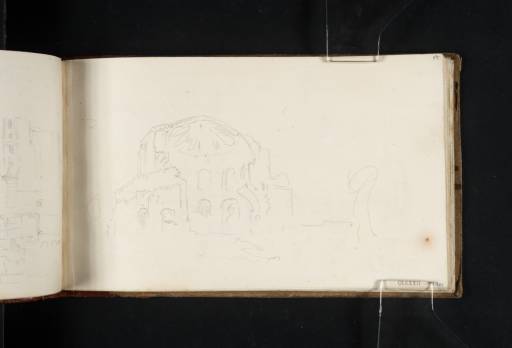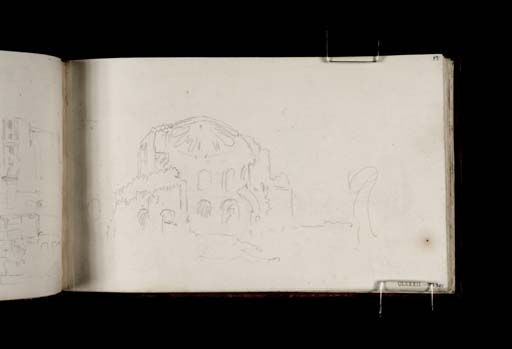Joseph Mallord William Turner Temple of Minerva Medica, Rome 1819
Image 1 of 2
Joseph Mallord William Turner,
Temple of Minerva Medica, Rome
1819
Joseph Mallord William Turner 1775–1851
Folio 56 Recto:
Temple of Minerva Medica, Rome 1819
D15401
Turner Bequest CLXXXII 55
Turner Bequest CLXXXII 55
Pencil on white wove paper, 113 x 189 mm
Inscribed by John Ruskin in blue ink ‘55’ top right and ‘301’ bottom right
Stamped in black ‘CLXXXII 55’ bottom right
Stamped in black ‘CLXXXII 55’ bottom right
Accepted by the nation as part of the Turner Bequest 1856
References
1909
A.J. Finberg, A Complete Inventory of the Drawings of the Turner Bequest, London 1909, vol.I, p.538, as ‘Temple of Minerva Medica.’.
The subject of this sketch was described by Charlotte Eaton in her travel guide to Rome, a series of letters written in 1817–8 and published in 1820:
In a lonely vineyard on the Esquiline Hill, stands the picturesque ruin of the Temple of Minerva Medica. Its form, though circular without, is decagonal within. It is built of brick, and is now stripped of every ornament. But the yawning chasms in its vaulted roof, the wild weeds that wave over it, the fallen masses that choke it up, the total destruction that threatens, and the solitude that surrounds it, give it an interest and a charm it probably never could have owned in a state of perfect preservation.1
The so-called Temple of Minerva Medica was one of Rome’s most frequently visited monuments, yet the building itself is something of a mystery. Popularly deriving its name from a statue found on site depicting the goddess Minerva with a snake (representative of the medical symbol of the caduceus) the circular structure has also been variously described as a nymphaeum or bath house and a dining pavilion.2 Today, the circular ruin stands between the railway tracks leading into Termini station and the present-day via Giovanni Giolotti, very close to the Porta Maggiore (also known as the Porta Praenestina), the subject of the page on the opposite sheet of the sketchbook, see folio 55 verso (D15400; Turner Bequest CLXXXII 54a). In the nineteenth century the area was a wasteland of Roman ruins. The Temple lay within a modern vineyard which Eustace recorded also contained ‘various subterranean vaulted apartments, some more, some less ornamented, the receptacles of the dead of various families.’3 Turner’s sketch shows that in 1819 the building still had the partial remains of a vaulted roof. This, however, collapsed in 1828.
In 1823, Marianne Colston wrote that the combination of the Temple’s ruined architecture with wild plants growing over it ‘presents the most picturesque and lovely object to the painter’.4 In fact, by the nineteenth century it had become a popular motif for artists, the people according to James Whiteside who had ‘succeeded the warriors and emperors who once dwelt in the eternal city.’5 Turner was familiar with the appearance of the monument through the work of others such as Giovanni Battista Piranesi,6 Richard Wilson,7 and James Hakewill.8 He had also painted it prior to seeing it for himself, as the subject in one of the plates of the Liber Studiorum, The Temple of Minerva Medica (‘Hindoo Devotions’ or ‘The Hindoo Worshipper’) circa 1808 (see Tate D08128; Turner Bequest CXVII A), engraved by Robert Dunkarton, 1811 (see Tate A00957).
There are a number of studies of the Temple within this sketchbook, see folios 46 verso, 56–57, 61 verso-62, 71 verso-72 verso (D15383, D15401–D15403, D15412–D15413, D15432–D15434; Turner Bequest CLXXXII 46a, 55–56, 60a–61, 70a–71a). Other sketches can also be found in the St Peter’s sketchbook (Tate D16318; Turner Bequest CLXXXVIII 87a), the Rome: Colour Studies sketchbook (Tate D16362 and D16363; Turner Bequest CLXXXIX 32 and 36) and the Small Roman Colour Studies sketchbook (Tate D16436–D16438; Turner Bequest CXC 27a–29).
Nicola Moorby
May 2008
Amanda Claridge, Judith Toms, Tony Cubberley, Rome: An Oxford Archaeological Guide, Oxford 1998, p.357.
Marianne Colston, Journal of a Tour in France, Switzerland and Italy in the Years 1819, 1820 and 1821, vol.1, London 1823, p.150.
James Whiteside, The Vicissitudes of the Eternal City: Or, Ancient Rome with Notes Classical and Historical, London 1849, p.94.
See Luigi Ficacci, Piranesi: The Complete Etchings, Köln and London 2000, nos.62, 165, 945, reproduced pp.94, 185, 727.
See Turner’s copy of Wilson’s River Landscape with Bathers, Cattle and Ruin in the Wilson sketchbook (Tate D01209–D01210; Turner Bequest XXXVIII 92–3; see also Ian Warrell, Blandine Chavanne and Michael Kitson, Turner et le Lorrain, exhibition catalogue, Musée des beaux-arts, Nancy 2002, p.50.
How to cite
Nicola Moorby, ‘Temple of Minerva Medica, Rome 1819 by Joseph Mallord William Turner’, catalogue entry, May 2008, in David Blayney Brown (ed.), J.M.W. Turner: Sketchbooks, Drawings and Watercolours, Tate Research Publication, December 2012, https://www


